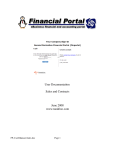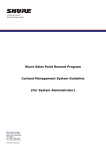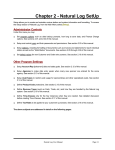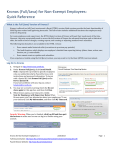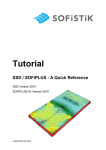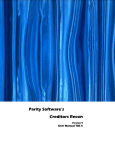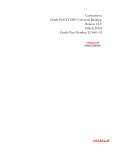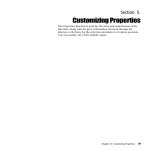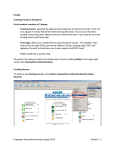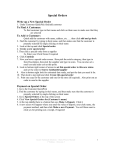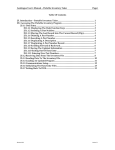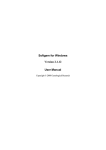Download User Documentation Purchasing and Receiving June
Transcript
User Documentation Purchasing and Receiving June 2008 www.randrinc.com FP_UserManual_Purchasing.doc Page 1 Table of Contents: Page: 1. Overview 3 2. Purchase Receipts 4 3. Purchase Orders 9 4. Warehouse Receipts 13 5. Additional Charges 15 6. Infoportal Reports 19 7. Financial Impact 21 FP_UserManual_Purchasing.doc Page 2 Overview of Purchasing: This is the Menu for Purchasing and Receiving. There are 3 main pieces: 1. Purchase Orders – You can create and update purchase orders. These will display in the Infoportal as open purchase orders. They represent commitments to buy products from your vendors 2. Warehouse Receipts – If you have a separate warehouse function, you can use the warehouse receipts. The users should enter exactly what they received. When the purchase receipt is created, you can pull in the warehouse receipt and all the items and quantities will automatically be pulled onto the Purchase Receipt. 3. Purchase Receipts – When you receive the goods, you use the purchase receipts to enter exactly what you have received. When you close the purchase receipt the open purchase order is updated, inventory is updated for the quantity received, and financial transactions are created in the general ledger for the $ amount of the inventory. Note, you do not have to have a Purchase Orders in order to use Purchase Receipts. The purpose of Purchase Orders are to recognize commitments to your vendors to purchase product. The purchase Receipt process shows what you actually received and puts those items into your on hand inventory. It also creates an obligation in your general ledger to show that you owe someone the money. Note if you do not want to use Purchasing and Receiving, you can get items into your inventory through the Inventory Module. See the Inventory User Manual. FP_UserManual_Purchasing.doc Page 3 Purchase Receipts: We put this first because you can run your business using only the purchase receipts to receive in the items that you have purchased. Purchase Receipts can be a stand alone receipt or can be receipts against an open purchase order (PO) Enter a PO if this is going to go against an open PO. Select a vendor or search for a vendor. If you created a warehouse receipts, then you can select from this screen, other wise, press the Add/Next. FP_UserManual_Purchasing.doc Page 4 Select an item from the drop down list or you can search for the item. Enter the cost and quantity. If you are entering weights as your quantity, you can enter a Tare weight for the container. By line you can link to a PO. You can enter comments for each line. Currently the system defaults to one warehouse. Press Add Item to add the line. If the delivery when through a scale, you can enter the weight or scale ticket information with the receipt. Press Create PO Receipt to create the receipt document. FP_UserManual_Purchasing.doc Page 5 This is the receipt confirmation screen. The Review PO Receipts screen allows you to review, print and receive the Items. You can search by vendor or item, by status, weight ticket #, bill of lading #, PO #. Click to search by creation date. Or just enter the receiver # at the top. FP_UserManual_Purchasing.doc Page 6 Search will bring you to a summary screen. Click on the receiver # on the left to get to the receiver. To receive the items, change the status of the receiver to Received and Press Update PO Receipt. If the item is a stocking item it will be added to inventory. See below for the financial transaction that is created. If you need to change the receipt you have two options, void the receipt or open it back up to change the quantities or add more items. Voiding a receipt reverses the financial and inventory transactions automatically. Then you would create a new purchase receipt. When you change the status to open it does not reverse out anything. After you make your changes and close the receipt only the changes amounts are posted to inventory and the general ledger. FP_UserManual_Purchasing.doc Page 7 To void the receipt, change the status to void and Update the PO Receipt. Voiding a receipt reverses the financial and inventory transactions automatically. You can also change the status back to open. Note, moving a receipt back to open does NOT reverse the financial transaction. You have to void the PO Receipt to reverse the financial transaction. However, if you move the PO receipt back to Open and then change any quantity, item, etc. when you move the status back to closed, the difference will post to the general ledger. When you are updating the receiver, click on the item number to change the information or delete the item from the receiver. FP_UserManual_Purchasing.doc Page 8 In Inventory management, inquiries, inventory audit, you can see the detail of the inventory receipt or sale. Purchase Orders: When you create a Purchase Order, you use one or more Purchase Receipts to receive the items. To create a purchase order, start by selecting the vendor from the list, or use the search function to search for the vendor. Click on the ... to search for items. FP_UserManual_Purchasing.doc Page 9 Select a catalog or enter part of the item # or description and press Select Item to search. Click on Select to select the item. It will be brought into the Purchase Order. Enter the cost and quantity. Press Add Item to add to the purchase order. You can enter comments for each line. FP_UserManual_Purchasing.doc Page 10 Select an order type. The other fields are optional. Press Create Purchase Order to create the Purchase Order. You can update the Purchase Order from here. FP_UserManual_Purchasing.doc Page 11 To review purchase orders, you have a variety of selection options. The list of purchase orders that match the criteria will be displayed. Click on the PO # to select the individual PO. You can change the PO. After the PO is closed you can no longer receive against the PO. FP_UserManual_Purchasing.doc Page 12 Once a Purchase Order is close it can not be changed. But you can change the status back to Open. Warehouse Receipts: Note, we discovered an error and remove the Warehouse Receipts from the menu, but we will add them back as soon as we can get the error fixed. To create a warehouse receipt, start by selecting the vendor or you can search (hum, does that look familiar?) FP_UserManual_Purchasing.doc Page 13 Start adding the items that are received (same as above). Gross weight is for the quantity or weight. Tare is the quantity or weight of the container. You can leave that as 0 if you are not receiving by weight in a container. Press Add Item to add the item to the warehouse receipt. You can also enter comments for each item. The fields at the bottom of the warehouse receipt are optional, but you can enter pertinent information here. When you are done, press Create Warehouse Receipt. Print to print the warehouse receipt. FP_UserManual_Purchasing.doc Page 14 The Review Warehouse Receipt allows for multiple different selection criteria. Select from the list or if you entered the Receipt number you will go directly to the individual receipt. You can make changes, add items. Clicking on the item in blue allows you to change it. To close the Warehouse Receipt, change the status to closed. Additional Charges: Additional Charges can be added to any open Purchase Order or Purchase Receipt. The purpose of the additional charges are to allow you to add a charge to a sales order, purchase order, or direct ship/brokerage transactions(future). These charges are used to allow us to easily associate all charges with a given transaction and therefore FP_UserManual_Purchasing.doc Page 15 easily see the true profit on all transactions. Note, some companies prefer to add different types of items/catalogs instead of using additional charges. These charges have to be defined first in the Create Charges Option. The charges are very flexible and allow you to do almost anything, but if they are not setup correctly or used correctly, you will not get the desired results. Press Add Charge to get the pop up charge window. Select the correct charge type. If this is a freight charge and you select a freight vendor, a transaction will be created in freight reconciliation. If this a commission charge and you select a Salesman, a transaction will be created in commission reconciliation. Here are some definitions : 4. Charge Definition 1. This drop down window shows you all the active charges and their descriptions. 2. Select one charge FP_UserManual_Purchasing.doc Page 16 5. Adjustment Type 1. This is a display only field, you can not change it. 2. This shows you how the charge type was set up originally 6. Adjustment Direction 1. The Adjustment amount is always entered as a positive number, so this option controls how profit, invoice amount and payment amount are impacted, either reduced or increased. 2. The options are positive or negative. 3. Based on how you set the Applies To option, it may also increase or decrease SO (invoice amount) or PO (payment amount). 7. Affects Payments – for example, if you added a commission charge that would not affect the payment, but a freight charge would. 1. If you check Affects Payments = Yes, then the charge will impact the amount of the payments (check) 1. If you check Adjustment Direction = Negative, then it will reduce the amount of the payment. 2. If you check Adjustment Direction = Positive, then it will increase the amount of the payment. Create Charge Definition Administration, Financial Setups, Create and Update Charge Definition. FP_UserManual_Purchasing.doc Page 17 Fill out all the fields and press Create Charge Definition to create a new Charge Code. The fields are; 1. 2. 3. 4. 5. 6. Adjustment Code – this is your name for the code, such as Ocean Freight Description – this is a large description of the code Category – there are 4 different categories for charge code and each one works differently. This is the list, the explanation is below: a. Freight b. Commission c. Payment Adjustment d. Other Adjustment type – this defines how the adjustment is calculated. This is the list, the explanation is below: a. Absolute Amount b. Percent of Total Dollars c. Per Pound Adjustment Must Associate with a Salesman – check this if a salesman MUST be entered when they use this charge code. To be added – GL account numbers to be used when we pass the transaction into the financial system. Category – Definitions: 1. 2. 3. Freight a. If a charge is coded as Freight, when it is passed into the financial system it will be added to the Freight Reconciliation Subsystem. This is used by accounting to reconcile freight billing. b. If a Freight charge is linked to a weight (either SO or PO), on the brokerage transition it will calculate and print the cost per pound. c. Freight charges can be added to an SO, PO or Brokerage Transaction. d. Freight charges can be set to impact SO or PO or not impact SO or PO. Commission a. If a charge is coded as Commission, when it is passed into the financial system it will be added to the Commission Reconciliation Subsystem. This is used to pay salesmen commissions. b. A Commission charge has to be linked to a weight (either SO or PO) if it is setup as a Per Pound Adjustment type. On the brokerage transaction it will calculate and print the rate per pound. c. Commission charges can be added to an SO, PO or Brokerage Transaction. d. Commission charges can be set to impact SO or PO or not impact SO or PO. Payment Adjustment a. Payment adjustments can NOT be added to SO, PO or Brokerage Transaction. b. The payment adjustment does not impact the profitability of any transaction. c. Payment adjustments only impact the dollar amount of a check. They can be used to increase or decrease a check amount for a shipper or vendor. FP_UserManual_Purchasing.doc Page 18 4. d. Payment adjustments are applied when you create the payment. Other a. All other charge types will be coded as Other. b. Other Charges can be added to an SO, PO or Brokerage Transaction. c. Other Charges can be set to impact SO or PO or not impact SO or PO. Adjustment Type: 1. 2. 3. Absolute Amount a. This amount does not vary if you link the charge to an SO or PO weight. b. For example, $150 for Freight. Percent of Total Dollars a. This is a percentage based on either SO or PO dollar(total) amount. b. For example, 2% Broker Fee on the SO. If the SO total amount was $36,000 , the total Broker Fee would be $700.00. Per unit(e.g. Quantity/Pound) Adjustment a. This is a dollar amount based on either SO or PO units (quantity/weight). b. For example, Commission Charge of $0.0025 per unit on the SO. If the SO weight were 36,000 pounds, the Commission amount would be $90. Information Portal Reports: The Activity Summary shows Open Purchase Orders. Drill down on the number in blue to see the detail. FP_UserManual_Purchasing.doc Page 19 Click on any column heading in blue to sort by that column. Click on the vendor number in blue to drill down to the detail. Currently there are no Historical Reports on Receipts, but these will be coming. Thanks for your patience. FP_UserManual_Purchasing.doc Page 20 Financial Impact of Purchasing: Purchase Orders and Warehouse Receipts do not create any financial transactions and they do not impact the on hand inventory. When you close a Purchase Receipt that is when the inventory is updated for the quantity received and a financial transaction is posted into the General Ledger. This is the financial transaction. You can review this in Financial Portal, General Ledger, Review Journal Entry: 2. Debit to inventory 3. Credit to purchase accrual account Note, if you debit or credit to a Profit and Loss account (non balance sheet), there will be a 2nd Journal Entry created that will either credit or debit to current year Retained Earnings (remember that every transaction closes the books). The inventory account that is used : The Item received is linked to a Catalog. Each catalog has a GL Code linked to it. In the Administration, Financial Setups, Sales/Pur GL – for each GL Code you have entered an Inventory account. This is where the inventory GL account number is defined. Purchase Accrual Account: In Administration, Financial Setups, Default GL Accounts is where you define the Purchasing Accrual GL Account to be used. Normally this will be a Liability account. On your balance sheet you will see this in the Liabilities. This represents monies that are owed to your vendors, but you have not received an invoice yet. When you get the vendor invoice and enter it into accounts payable as a vendor voucher, you will credit Accounts Payable and debit the Purchase Accrual account for the amount of the receipt. Freight, variances, etc should be debited to their respective GL Accounts.. Now when you look at your balance sheet the amount owed to the vendor will not be in the Purchase Accrual account, but will be in Accounts Payable. Also the vendor invoice will display in the Accounts Payable aging in Financial Portal, Accounts Payable and in the Infoportal Reports. Currently we do not have matching of PO receipts to the invoice. When you void a purchase receipt the financial and inventory transactions are automatically reversed. FP_UserManual_Purchasing.doc Page 21 Here are the financial transactions from the original receipt and the void of the receipt. If you change the status of a purchase receipt back to open it does NOT reverse the financial transaction. You have to void the PO Receipt to reverse the financial transaction. However, if you move the PO receipt back to Open and then change any quantity, item, etc. when you move the status back to closed, only the difference will post to the general ledger. In Inventory management, Inquiries, Inventory audit, you can see the detail of the inventory receipt or sale. FP_UserManual_Purchasing.doc Page 22






















